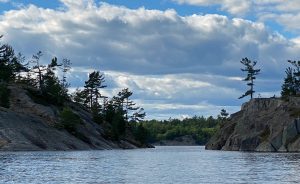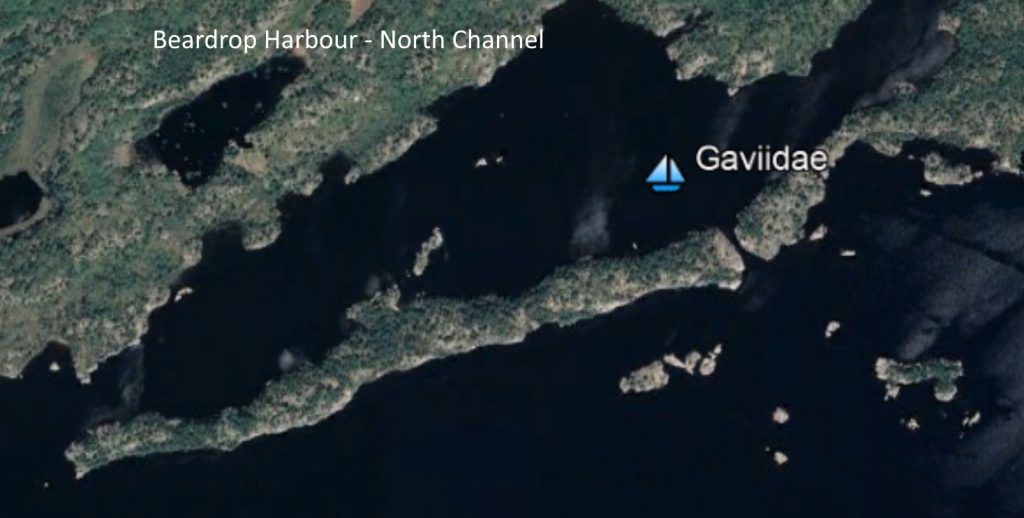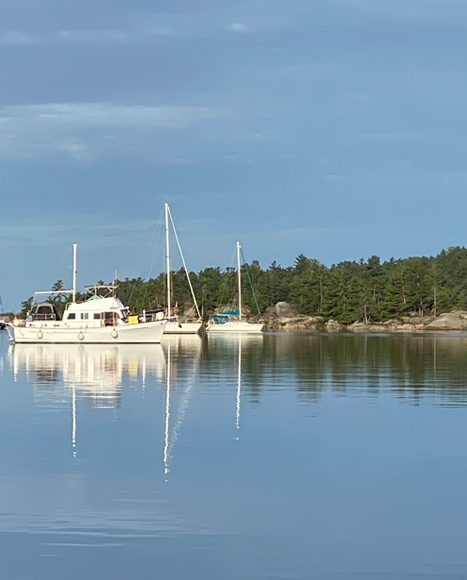“Anchor as though you plan to stay for weeks, even if you intend to leave in an hour.”
– Irish sailor Tommy Moran
Dragging anchor is a concern that keeps careful sailors awake at night. If the wind changes—either in strength or direction—the change can resonate in the rigging. Tide or wind change can shift the orientation of a boat and prompt the anchor tackle to clank or grind. Or it can affect the rocking motion of the boat. Any changes like that get our attention and can wake us from deep slumber.
Anchoring Challenges
Setting an anchor to secure a boat is a seemingly easy, straightforward task: Tie a heavy object with a hooked point to your boat and drop it overboard. However, anchoring a boat is a deceptively complicated proposition. Nearly everything about sailing is a mix of science and art, with varying amounts of luck thrown in. Anchoring is no exception. Water depth, wind speed and direction, tide or current and bottom conditions and type of anchor all factor in a secure anchor set. It isn’t rocket science but fail to follow some fundamental rules and your anchor could dislodge from the bottom and your boat could drift untethered, risking damage to your boat and/or other nearby boats.
While I’ve had trouble setting anchor in some grassy or rocky beds, I haven’t dragged anchor yet. Knock on wood. I’ve had an anchor roll and reset in a wild storm with sustained 30 knot winds gusting to near 50 knots, but the boat was never dangerously adrift. I know because I rode that storm out in the cockpit monitoring our GPS position, the depth finder and our position relative to shoreline or other features whenever lightning flashes made them visible in the dark and driving rain. I also had the engine running—just in case. In raising the Mantus anchor the next morning, it was clear it was set over 90 degrees off the direction we faced when we set anchor the previous afternoon.
We’ve observed boats around us drag anchor in the Great Lakes and the Caribbean and have had our anchor rolled by other boats carelessly setting or weighing anchors.
Our most recent close encounter with an unmoored boat occurred on a windy August afternoon.
Peaceful Day in Beardrop
The day started as a serene, nearly cloudless morning in Beardrop Harbour in the North Channel. Beardrop is a popular anchorage in the western reaches of a scenic stretch of the North Channel. We were sharing the west half of the mile-long harbor with a half-dozen other sail- and motorboats. The shoreline’s mix of cliffs and vegetation and the boats were mirrored on the calm, blue-green water. The effect was that of kaleidoscopic Rohrsarch tests.
Dark evergreens, deciduous trees and bushes frame the cliffs and narrow strips of rocky shoreline and outcrops. Variegated shades of gray and pink granite veined with limestone, quartzite and all kinds of sedimentary minerals provide contrast and color and texture. All this geology was laid down and compressed over aeons by the comings and goings of oceans, volcanic upheavals, glaciers and continental drift. These metamorphic rock formations are seen throughout Georgian Bay and Lake Huron along the southeast edges of the Canadian Shield. They reveal the convulsive history of Earth over millions of years; a history laid bare by the erosive onslaught of wind, water and ice.
Beardrop – The Name

Beardrop Harbour is defined by the wooded and rocky mainland on its north shore. Two equally rocky and treed unnamed islands separate the harbor from the Whalesback Channel to the south. Halfway along the westmost island a rocky islet sits athwart the entry channel, protecting the roughly 33-acre harbor from westerly winds. A narrow gap between the long islands marks the eastern reach of the anchorable part of the harbor. That gap has high, steep walls and is known among indigenous Ojibweg people as “Bear Fall.”
According to legend, a bear was observed falling into the harbor from one of the walls at the gap. It might be that the bear was practicing a reverse-somersault-with-twists in pike-fishing position for some prehistoric north-woods Olympiad. More likely it was just a clumsy bear that lost its footing while foraging for blueberries atop the cliff. English-speaking interlopers gave the gorgeous harbor its current, somewhat candy-fied Beardrop name.
In this idyllic setting Julie and I were taking care of some boat chores. We had arrived in Beardrop the previous afternoon from Blind River, a small town with a nice marina 15 nm to the west. Having done laundry, provisioning, taking on water and getting a much-needed pump out of the holding tank, we were set for another couple of weeks of the peace and quiet so often found in wilderness anchorages. Beardrop was our first destination and we anchored far back near the Beardrop cut and away from the other boats.
Hearing Voices
A mid-morning breeze stirred out of the west, ushering in scudding clouds and stirring the water despite the island that sits athwart the west entrance to the harbor. By noon, the sun had disappeared behind heavy clouds; 14 knot winds were gusting into the 20s, creating considerable chop in the cove.
We were below decks checking our house battery bank when we heard voices. Thinking the voices sounded too close, Julie went up to the cockpit to investigate. “Daniel, get up here!” she shouted. “There’s boat coming down on us!”
As I sprang up the companionway into the cockpit Julie motioned forward — to windward. I was stunned to see a mast slashing the air mere feet in front of us, slightly to starboard. We were under assault! Shouts and the noise of revving motors carried down the wind to us and I scrambled out of the cockpit and along the foredeck.
Arriving at the front of the boat, I could see the back of a white-haired guy in the cockpit of a sailboat half our size. He was simultaneously grappling with the small boat’s tiller and its outboard motor to keep his boat from sliding sideways under our bowsprit! His outboard’s prop thrashed the water in a futile attempt to power the boat away from our boat. The little boat was sideways to the wind — and to Gaviidae. The outboard was inadequate to counter the force of the wind. He and his cockpit was nearly under our bowsprit!
Earlier Encounter
Realizing his predicament, the man in the boat released the tiller and swung around to grab the upper portion of our martingale stay to keep his boat at bay. The martingale is a cable running from beneath the bowsprit through a spar called a dolphin striker. The cable continues through to a bobstay tang mounted on the hull. This rigging is meant to countervail the forestay, which is the sail-carrying rig between the bowsprit and the mast. When I saw his face, I quickly realized I knew this would-be Samson!
I think his name is Peter. He had buttonholed me on the dock in Blind River a couple days before and expounded at great length about sailboats made in Canada. For all his expertise, he was unfamiliar with Gozzard, which has been making sailboats in Goderich, Ontario for 35 years. Gaviidae is a Gozzard. Peter’s banter also implied having a lot of sailing experience. He and his crewmate, Jane, were on a 25-foot Canadian-made sailboat named Shaman.
I shouted to Julie—who followed me forward–to hand me a boathook. I figured that it was my best bet to help keep the other boat at bay. After handing me a boathook, Julie dropped a couple of fenders to starboard to protect our hull and its expensive paint job should Shaman pivot alongside us—which seemed likely. Julie flew back to the cockpit to fire up the engine in case we needed to maneuver. She also turned on the anchor windlass.
Our dinghy was in the water, but the battery for the electric motor was stowed below decks. Even if the motor had been ready to go, maneuvering the dinghy in the high wind to act as an on-water fender was not an option. As I alternately plied my boathook to pull up the snubber and keep Shaman at bay, I realized that this guy had talked mostly about race sailing and about one-design boats built for racing. He had very selective knowledge about sailing.
Scrambling
I surmised that Peter and Jane had cruised into Beardrop on the building winds and attempted to anchor upwind from us. They were apparently unable to set the anchor and their outboard motor proved inadequate in the gusty winds. Despite the fact that we were at least 50 yards off the shoreline to port and a quarter mile from the mainland to starboard, the wind pushed them directly down on us.
As Peter struggled in the cockpit, Jane was sprawled across Shaman‘s foredeck wrestling with the boat’s anchor rode. She was getting assistance from a guy in a dinghy. It was Kevin, the skipper from a nearby sailboat who witnessed Shaman‘s problems. The small sailboat’s anchor rode appeared to be entangled with our anchor chain and snubber. We had deployed about 60 feet of anchor chain and the snubber was attached six or seven feet down the chain from the water’s surface. We were parked in 12 feet of water.
Backups to the Rescue
In short order, another dinghy roared up to help. In the ensuing chaos we feared Shaman‘s keel was caught up in our anchor chain. The driver of the new dinghy tied onto Shaman and began pulling her away from Gaviidae. Meanwhile, Kevin maneuvered his dinghy to better help Jane haul Shaman‘s anchor rode. Kevin soon verified Shaman‘s rode and anchor were making whoopee with our snubber and chain!
I hit the windlass to raise the chain and make the entangled ground tackle more accessible to Kevin and Jane. With some effort, they were able to separate Shaman‘s rode and anchor from our equipment. The two dinghies were then able to drag Shaman away from our boat.
We watched nervously as the little sailboat was towed upwind from us to anchor again. Several attempts to set their hook in the mud bottom all failed. Clearly Shaman‘s ground tackle was inadequate to secure the boat in any serious wind. To our relief, the second dinghy eventually guided Shaman around us and out the east end of the harbor to find a presumably quieter anchorage out of the wind. The escort dinghy returned shortly to fetch another anchor and rode to loan to Shaman in their new anchorage.
Many thanks to Kevin and the other dinghy operator who helped keep Shaman at bay. And good luck to Shaman and her crew. We hope to never again see them upwind from us in an anchorage.

Monday, August 17, Beardrop Harbour, North Channel 46° 09.69’ N, 082° 37.49’ W


What a story! My heart was beating! Glad damage was avoided through the quick of several sailors.